高中英语语法:副词yet的用法
- 格式:doc
- 大小:24.00 KB
- 文档页数:3
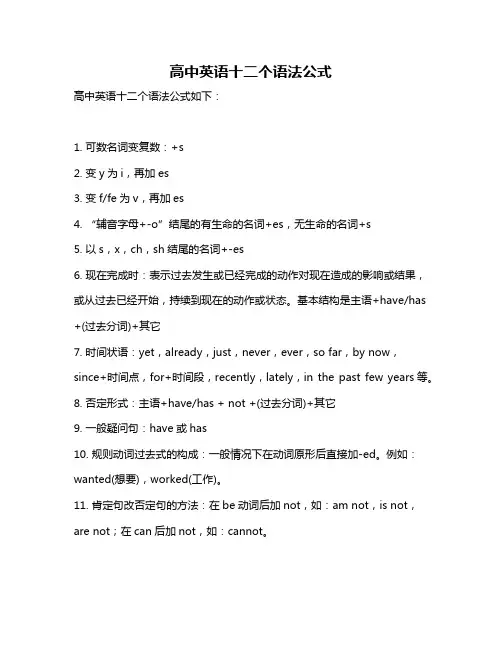
高中英语十二个语法公式高中英语十二个语法公式如下:1. 可数名词变复数:+s2. 变y为i,再加es3. 变f/fe为v,再加es4. “辅音字母+-o”结尾的有生命的名词+es,无生命的名词+s5. 以s,x,ch,sh结尾的名词+-es6. 现在完成时:表示过去发生或已经完成的动作对现在造成的影响或结果,或从过去已经开始,持续到现在的动作或状态。
基本结构是主语+have/has +(过去分词)+其它7. 时间状语:yet,already,just,never,ever,so far,by now,since+时间点,for+时间段,recently,lately,in the past few years等。
8. 否定形式:主语+have/has + not +(过去分词)+其它9. 一般疑问句:have或has10. 规则动词过去式的构成:一般情况下在动词原形后直接加-ed。
例如:wanted(想要),worked(工作)。
11. 肯定句改否定句的方法:在be动词后加not,如:am not,is not,are not;在can后加not,如:cannot。
12. 形容词和副词的比较级和最高级的构成:一般情况直接加-er或-est。
例如:smarter、fastest。
以不发音的字母e结尾的形容词和副词的比较级和最高级加-r和-st。
例如:better、brightest。
重读闭音节词的辅音字母双写构成的形容词和副词的比较级和最高级加-er和-est。
例如:biggest、hottest。
以上就是高中英语十二个语法公式,希望对解决您的问题有所帮助。
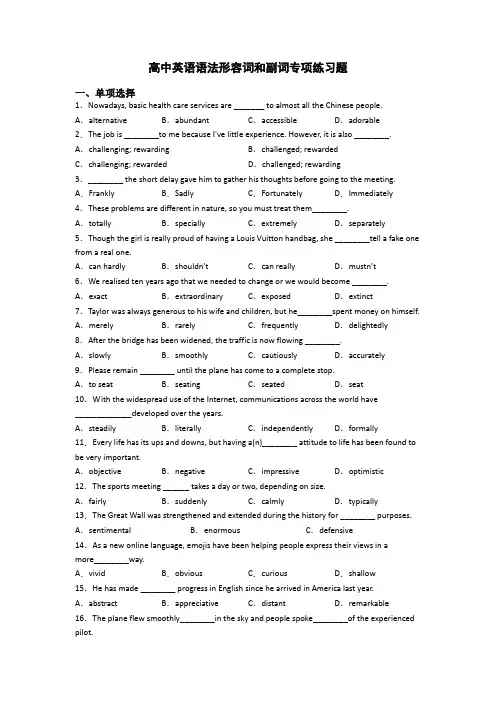
高中英语语法形容词和副词专项练习题一、单项选择1.Nowadays, basic health care services are _______ to almost all the Chinese people. A.alternative B.abundant C.accessible D.adorable2.The job is ________to me because I've little experience. However, it is also ________. A.challenging; rewarding B.challenged; rewardedC.challenging; rewarded D.challenged; rewarding3.________ the short delay gave him to gather his thoughts before going to the meeting. A.Frankly B.Sadly C.Fortunately D.Immediately 4.These problems are different in nature, so you must treat them________.A.totally B.specially C.extremely D.separately 5.Though the girl is really proud of having a Louis Vuitton handbag, she ________tell a fake one from a real one.A.can hardly B.shouldn’t C.can really D.mustn’t6.We realised ten years ago that we needed to change or we would become ________. A.exact B.extraordinary C.exposed D.extinct7.Taylor was always generous to his wife and children, but he________spent money on himself. A.merely B.rarely C.frequently D.delightedly 8.After the bridge has been widened, the traffic is now flowing ________.A.slowly B.smoothly C.cautiously D.accurately 9.Please remain ________ until the plane has come to a complete stop.A.to seat B.seating C.seated D.seat10.With the widespread use of the Internet, communications across the world have_____________developed over the years.A.steadily B.literally C.independently D.formally 11.Every life has its ups and downs, but having a(n)________ attitude to life has been found to be very important.A.objective B.negative C.impressive D.optimistic 12.The sports meeting ______ takes a day or two, depending on size.A.fairly B.suddenly C.calmly D.typically13.The Great Wall was strengthened and extended during the history for ________ purposes. A.sentimental B.enormous C.defensive14.As a new online language, emojis have been helping people express their views in amore________way.A.vivid B.obvious C.curious D.shallow15.He has made ________ progress in English since he arrived in America last year. A.abstract B.appreciative C.distant D.remarkable 16.The plane flew smoothly________in the sky and people spoke________of the experienced pilot.A.high; high B.high; highly C.highly; highly D.highly, high 17.She found it difficult to do the work.句子的宾语补足语是________A.She B.found C.it D.difficult18.The speech was so ________ that they were all ________.A.inspiring; exciting B.inspiring; excitedC.inspired; excited D.inspired; exciting19.Victor is a man of few words but with a sense of humor. We all like him very much. A.delightful B.delightfully C.delighted D.delightedly 20.He has never studied English before, and ________we should give him more help. A.therefore B.so C.so that D.however 21.You don’t need to wear a suit; it’s an ________ meeting.A.informal B.recognise C.gradually D.frog22.I find preparing for an examination quite stressful. 选出划线词的词性。
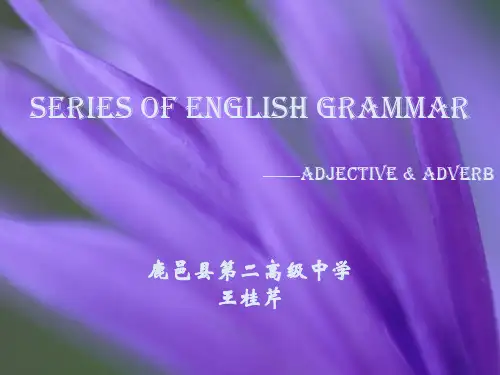
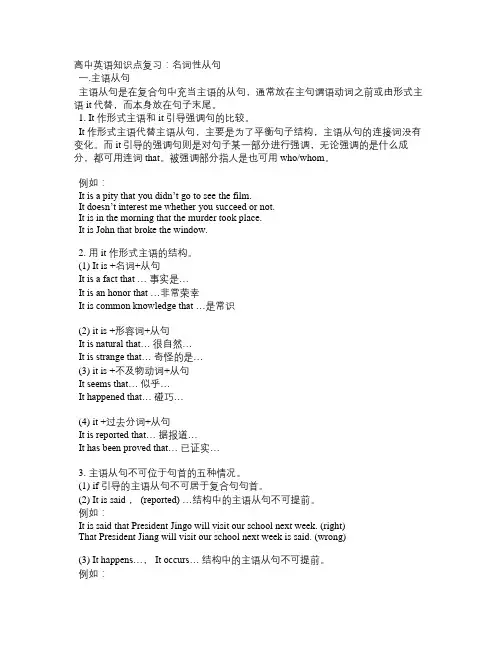
高中英语知识点复习:名词性从句一.主语从句主语从句是在复合句中充当主语的从句,通常放在主句谓语动词之前或由形式主语it代替,而本身放在句子末尾。
1. It 作形式主语和it引导强调句的比较。
It 作形式主语代替主语从句,主要是为了平衡句子结构,主语从句的连接词没有变化。
而it引导的强调句则是对句子某一部分进行强调,无论强调的是什么成分,都可用连词that。
被强调部分指人是也可用who/whom。
例如:It is a pity that you didn’t go to see the film.It doesn’t interest me whether you succeed or not.It is in the morning that the murder took place.It is John that broke the window.2. 用it 作形式主语的结构。
(1) It is +名词+从句It is a fact that … 事实是…It is an honor that …非常荣幸It is common knowledge that …是常识(2) it is +形容词+从句It is natural that… 很自然…It is strange that… 奇怪的是…(3) it is +不及物动词+从句It seems that… 似乎…It happened that… 碰巧…(4) it +过去分词+从句It is reported that… 据报道…It has been proved that… 已证实…3. 主语从句不可位于句首的五种情况。
(1) if 引导的主语从句不可居于复合句句首。
(2) It is said ,(reported) …结构中的主语从句不可提前。
例如:It is said that President Jingo will visit our school next week. (right)That President Jiang will visit our school next week is said. (wrong)(3) It happe ns…,It occurs… 结构中的主语从句不可提前。
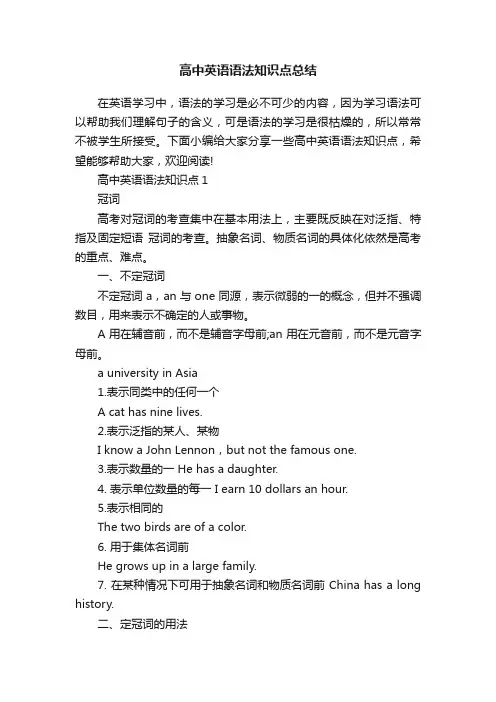
高中英语语法知识点总结在英语学习中,语法的学习是必不可少的内容,因为学习语法可以帮助我们理解句子的含义,可是语法的学习是很枯燥的,所以常常不被学生所接受。
下面小编给大家分享一些高中英语语法知识点,希望能够帮助大家,欢迎阅读!高中英语语法知识点1冠词高考对冠词的考查集中在基本用法上,主要既反映在对泛指、特指及固定短语冠词的考查。
抽象名词、物质名词的具体化依然是高考的重点、难点。
一、不定冠词不定冠词a,an与one同源,表示微弱的一的概念,但并不强调数目,用来表示不确定的人或事物。
A用在辅音前,而不是辅音字母前;an用在元音前,而不是元音字母前。
a university in Asia1.表示同类中的任何一个A cat has nine lives.2.表示泛指的某人、某物I know a John Lennon,but not the famous one.3.表示数量的一 He has a daughter.4. 表示单位数量的每一 I earn 10 dollars an hour.5.表示相同的The two birds are of a color.6. 用于集体名词前He grows up in a large family.7. 在某种情况下可用于抽象名词和物质名词前 China has a long history.二、定冠词的用法1.表示特定的人或物2.表示地球、宇宙中独一无二的事物主要指各种天体及世界上比较有影响的物体。
The sun,the moon,the earth3.表示地点、方向、时间、方式等 at the corner 在拐角处1) 在表示季节的名词前常不用冠词。
In spring 在春天2) 具体某年的某个季节,需用冠词。
In the summer of the year20083)用于序数词或形容词的最高级前 the first the second4)用于形容词前使其名词化 the rich the poor5)用于复数姓氏前,表示―夫妇‖或全家 The Smiths6)用于乐器名词前 Play the piano7)用于by+the+计量单位名词 By the pound1. 用于复数名词前复数名词泛指某类人或物时,其前通常用零冠词。
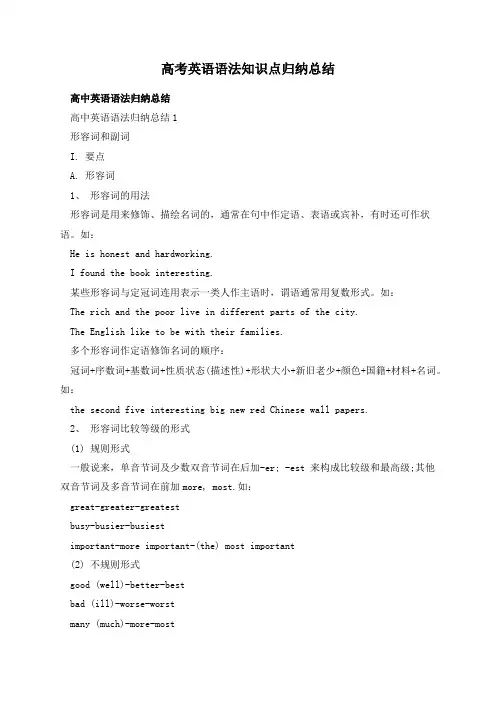
高考英语语法知识点归纳总结高中英语语法归纳总结高中英语语法归纳总结1形容词和副词I. 要点A. 形容词1、形容词的用法形容词是用来修饰、描绘名词的,通常在句中作定语、表语或宾补,有时还可作状语。
如:He is honest and hardworking.I found the book interesting.某些形容词与定冠词连用表示一类人作主语时,谓语通常用复数形式。
如:The rich and the poor live in different parts of the city.The English like to be with their families.多个形容词作定语修饰名词的顺序:冠词+序数词+基数词+性质状态(描述性)+形状大小+新旧老少+颜色+国籍+材料+名词。
如:the second five interesting big new red Chinese wall papers.2、形容词比较等级的形式(1) 规则形式一般说来,单音节词及少数双音节词在后加-er; -est 来构成比较级和最高级;其他双音节词及多音节词在前加more, most.如:great-greater-greatestbusy-busier-busiestimportant-more important-(the) most important(2) 不规则形式good (well)-better-bestbad (ill)-worse-worstmany (much)-more-mostlittle-less-least(3) 形容词比较等级的用法①表示两者的比较,用形容词的比较级+than. 如:He is cleverer than the other boys.This one is more beautiful than that one.②表示两者以上的比较,用the +形容词最高级(+名词)+of(in) …如:He is the cleverest boy in his class.③表示两者是同等程度,用as +形容词原级+as. 如:He is as tall as I.I have as many books as you.④ 越… 越…例如:The more I learn, the happier I am.⑤ You can never be too careful. 越小心越好又如:You can never praise the teacher too highly.你怎么赞扬这个老师也不过分。
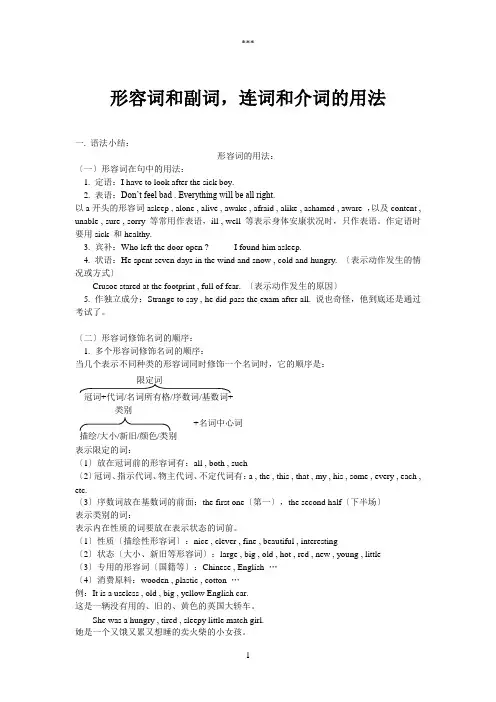
形容词和副词,连词和介词的用法一. 语法小结:形容词的用法:〔一〕形容词在句中的用法:1. 定语:I have to look after the sick boy.2. 表语:Don’t feel bad . Everything will be all right.以a开头的形容词asleep , alone , alive , awake , afraid , alike , ashamed , aware ,以及content , unable , sure , sorry 等常用作表语,ill , well 等表示身体安康状况时,只作表语。
作定语时要用sick 和healthy.3. 宾补:Who left the door open ? I found him asleep.4. 状语:He spent seven days in the wind and snow , cold and hungry. 〔表示动作发生的情况或方式〕Crusoe stared at the footprint , full of fear. 〔表示动作发生的原因〕5. 作独立成分:Strange to say , he did pass the exam after all. 说也奇怪,他到底还是通过考试了。
〔二〕形容词修饰名词的顺序:1. 多个形容词修饰名词的顺序:当几个表示不同种类的形容词同时修饰一个名词时,它的顺序是:限定词冠词+代词/名词所有格/序数词/基数词类别+名词中心词描绘/大小/新旧/颜色/类别表示限定的词:〔1〕放在冠词前的形容词有:all , both , such〔2〕冠词、指示代词、物主代词、不定代词有:a , the , this , that , my , his , some , every , each , etc.〔3〕序数词放在基数词的前面:the first one〔第一〕,the second half〔下半场〕表示类别的词:表示内在性质的词要放在表示状态的词前。
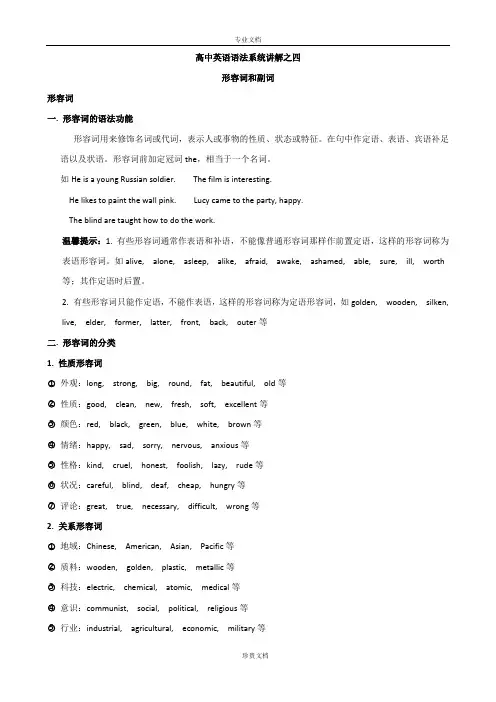
高中英语语法系统讲解之四形容词和副词形容词一. 形容词的语法功能形容词用来修饰名词或代词,表示人或事物的性质、状态或特征。
在句中作定语、表语、宾语补足语以及状语。
形容词前加定冠词the,相当于一个名词。
如He is a young Russian soldier. The film is interesting.He likes to paint the wall pink. Lucy came to the party, happy.The blind are taught how to do the work.温馨提示:1. 有些形容词通常作表语和补语,不能像普通形容词那样作前置定语,这样的形容词称为表语形容词。
如alive, alone, asleep, alike, afraid, awake, ashamed, able, sure, ill, worth 等;其作定语时后置。
2. 有些形容词只能作定语,不能作表语,这样的形容词称为定语形容词,如golden, wooden, silken,live, elder, former, latter, front, back, outer等二. 形容词的分类1. 性质形容词○1外观:long, strong, big, round, fat, beautiful, old等○2性质:good, clean, new, fresh, soft, excellent等○3颜色:red, black, green, blue, white, brown等○4情绪:happy, sad, sorry, nervous, anxious等○5性格:kind, cruel, honest, foolish, lazy, rude等○6状况:careful, blind, deaf, cheap, hungry等○7评论:great, true, necessary, difficult, wrong等2. 关系形容词○1地域:Chinese, American, Asian, Pacific等○2质料:wooden, golden, plastic, metallic等○3科技:electric, chemical, atomic, medical等○4意识:communist, social, political, religious等○5行业:industrial, agricultural, economic, military等三. 形容词在句中的位置1.单个形容词作定语时,一般放在被修饰的名词之前;两个或两个以上的形容词修饰一个名词时,同种类形容词的排列顺序一般应考虑以下两种情况:○1和被修饰的名词关系比较密切的形容词位置更靠近名词。
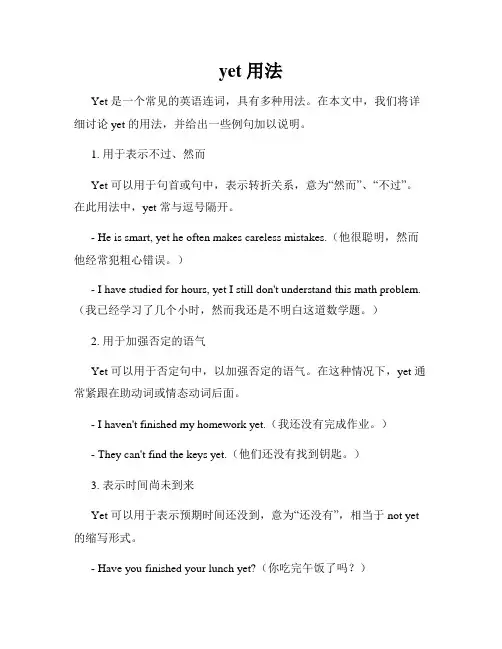
yet 用法Yet 是一个常见的英语连词,具有多种用法。
在本文中,我们将详细讨论 yet 的用法,并给出一些例句加以说明。
1. 用于表示不过、然而Yet 可以用于句首或句中,表示转折关系,意为“然而”、“不过”。
在此用法中,yet 常与逗号隔开。
- He is smart, yet he often makes careless mistakes.(他很聪明,然而他经常犯粗心错误。
)- I have studied for hours, yet I still don't understand this math problem.(我已经学习了几个小时,然而我还是不明白这道数学题。
)2. 用于加强否定的语气Yet 可以用于否定句中,以加强否定的语气。
在这种情况下,yet 通常紧跟在助动词或情态动词后面。
- I haven't finished my homework yet.(我还没有完成作业。
)- They can't find the keys yet.(他们还没有找到钥匙。
)3. 表示时间尚未到来Yet 可以用于表示预期时间还没到,意为“还没有”,相当于 not yet 的缩写形式。
- Have you finished your lunch yet?(你吃完午饭了吗?)- He hasn't arrived yet.(他还没有到达。
)4. 用于疑问句中,表示期待的回答Yet 也可以用于疑问句中,表示期待对方给出预期的回答。
在这种情况下,yet 通常放在句末。
- Is the project finished yet?(这个项目已经完成了吗?)- Have you made a decision yet?(你已经做出决定了吗?)5. 与 still 连用,表示强调时间延续Yet 还可以与still 连用,用于强调某种情况的持续。
在这种情况下,yet 通常放在句末。

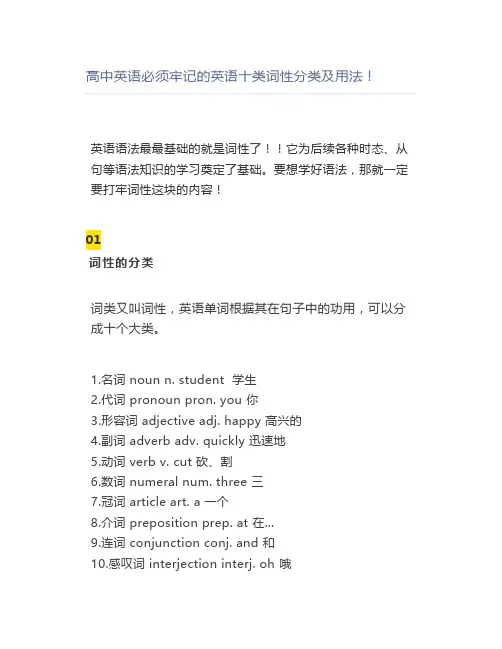
高中英语必须牢记的英语十类词性分类及用法!英语语法最最基础的就是词性了!!它为后续各种时态、从句等语法知识的学习奠定了基础。
要想学好语法,那就一定要打牢词性这块的内容!01词性的分类词类又叫词性,英语单词根据其在句子中的功用,可以分成十个大类。
1.名词 noun n. student 学生2.代词 pronoun pron. you 你3.形容词 adjective adj. happy 高兴的4.副词 adverb adv. quickly 迅速地5.动词 verb v. cut 砍、割6.数词 numeral num. three 三7.冠词 article art. a 一个8.介词 preposition prep. at 在...9.连词 conjunction conj. and 和10.感叹词 interjection interj. oh 哦前六类叫实词,后四类叫虚词。
下面就一一介绍02名词名词复数的规则变化名词的格在英语中有些名词可以加“‘s”来表示所有关系,带这种词尾的名词形式称为该名词的所有格,如:a tea cher’s book。
名词所有格的规则如下:1)单数名词词尾加“'s”,复数名词词尾没有s,也要加“'s”,如the boy‘s bag 男孩的书包,men’s room 男厕所。
2)若名词已有复数词尾-s ,只加“'”,如:the workers’ struggle工人的斗争。
03代词大多数代词具有名词和形容词的功能。
英语中的代词,按其意义、特征及在句中的作用分为:人称代词、物主代词、指示代词、反身代词、相互代词、疑问代词、关系代词、连接代词和不定代词九种。
人称代词的用法I saw her with them,at least, I thought it was her.我看到她和他们在一起,至少我认为是她。
(her做宾语,them做介词宾语,her作主补)a. -- Who broke the vase?--谁打碎了花瓶?b. -- Me.--我。
介词和介词短语1、介词是一种用来表示词与词、词与句之间的关系的虚词,在句中不能单独作句子成分。
介词后面一般有名词代词或相当于名词的其他词类,短语或从句作它的宾语。
介词和它的宾语构成介词词组,在句中作状语,表语,补语或介词宾语。
介词可以分为时间介词、地点介词、方式介词和其他介词。
1)时间介词:at, in, after, by, before, during, since, for, until, from 2)地点介词:in, at, on, over, under, below, near, behind, by3)方式介词:with, by, like, in, without等2、介词和其他代词或名词搭配形成介词短语。
介词短语在句中可以作状语,定语,表语,补足语等。
1)作表语例如:It was in 2005 in Beijing.2)作宾语补足语例如:He found his dog outside the station.3)作后置定语例如:I even store them in boxes under my bed. 4)作状语例如:You are supposed to put your bread on your plate.状语从句1、地点状语从句地点状语从句通常由where, wherever 引导。
Where I live there are plenty of trees.我住的地方树很多。
Wherever I am I will be thinking of you.不管我在哪里我都会想到你。
2、方式状语从句方式状语从句通常由as, (just) as…so…, as if, as though 引导。
1)as, (just) as…so…引导的方式状语从句通常位于主句后,但在(just) as…so…结构中位于句首,这时as从句带有比喻的含义,意思是“正如…”,“就像”,多用于正式文体,例如:Always do to the others as you would be done by.你希望人家怎样待你,你就要怎样待人。
高中英语语法专题副词与必背短语英语老师总是说“程度副词”,当时真的似懂非懂的,很朦胧的感觉。
现在想想,很多副词不就是交代程度的吗?,如何学好英语?小编在这里整理了相关资料,快来学习学习吧!高中英语语法专题副词一、概念副词(Adverb 简称adv.)是指在句子中表示行为或状态特征的词,用以修饰动词、形容词、副词本身的词。
①副词修饰动词 He runs fast. 他跑得很快。
②副词修饰形容词 He is very clever. 他很聪明。
③副词修饰副词 I can dance very well. 我跳舞跳得不错。
二、副词分类时间副词(today,ago)、地点副词(here,upstairs)、程度副词(very,so)、方式副词(fast,loudly) 、疑问副词(when,how)、关系副词(when,where等常用来引导定语从句)、频率副词(often,never). 需要注意副词在句子中的位置,表示地点、时间、方式的副词通常放在句末,而频率副词和程度副词通常放在助动词后,实义动词前,即“助后动前”。
三、形容变副词1. 形容词词尾加ly 例如:loud-loudly slow-slowly2. 形容词以辅音字母加y结尾,去掉y变i加ly 例如:heavy-heavily happy-happily3. 部分形容词以e结尾,去掉e再加ly 例如:whole-wholly true-truly4. 特殊变化例如:good-well5. 形容词副词同形例如:late-late hard-hard fast-fast四、副词在句子中的成分1. 副词作状语例如:She studies hard.她学习很用功 (hard作方式状语修饰动词study)2. 副词作定语例如:He likes the pictures there. 他喜欢那儿的图画.(there修饰pictures作定语)3. 副词作表语例如:I’m home.我到家了。
最新高中英语语法知识点总结中学英语语法学问点简洁句、并列句、复合句1. 简洁句句型:主语+谓语只包含一个主谓结构,而句子的各个结构都只由单词或短语表示。
2. 并列句句型:简洁句+并列连词(或连接副词)+简洁句由两个或两个以上的简洁句并列连接起来的句子叫并列句。
并列句中的各简洁句意义同等重要,相互之间没有从属关系,是平行并列的关系。
它们之间用连词连结。
1、联合关系:常用的连词有and, not only…but(also), neither…nor等。
Eg. Tom doesn’t smoke, nor does his brother.2、转折关系常用的连词有but, yet, still, however, while(而,然而),when(那时,然后)等。
Eg. He got up very early, (and) yet he failed to catch the morning train.We played outside till sunset, when it began to rain.She is tired, (but) still she will make another test.yet 和still是连接副词,又叫半连接句。
however(然而,不过,但是)意义接近yet,可放在句首、句末或插入句子中间。
3、选择关系:常用的连词有or(或者,还是,否则),otherwise, or else, either…or 等。
Eg. Hurry up, or we’ll be late for school.4、因果关系连词有:for, so, thus, therefore, and so 等。
Eg. He studied hard, thus he succeeded in passing the exam.The Frenchman coughed loudly, so he decided to go and get some medicine for it.for 表示附加或推断的理由、缘由。
高中英语语法复习专题讲解-形容词副词一、考点聚焦1、形容词、副词的作用与位置形容词是用来修饰名词的,常被放在名词前作定语,或放在系动词后面作表语。
而副词则用来修饰形容词、动词,其他副词或者句子,一般位于形容词之前,动词之后或句子之首。
以下属几种特殊情况,须牢记;(1)形容词短语作定语,定语后置。
a language difficult to master, a leaning tower about 180 feet high(2)表语形容词(afraid、alike、alone、asleep、awake、alive等)作定语,定语后置。
如a man alive。
有些表身体健康状况的形容词如well、faint、ill只作表语。
sick既可作表语又可作定语,ill如作定语意为“bad”。
(3)用作定语,修饰由不定代词one、no、any、some和every构成的复合词如anything、something等时,通常后置。
如:I have something important to tell you.(4)else常用作疑问代词和不定代词的后置定语。
(5)enough、nearby修饰名词前置或后置,程度副词一般位于形容词、副词前面,enough修饰形容词、副词时,必须后置。
(6)几个副词并列作状语时,其顺序较灵活,但一般是:方式→地点→时间。
如:We had a good time together outdoors last Sunday.(7)频度副词如often、always、usually等在be动词后,行为动词前。
(8)副词作定语,定语后置。
如:The person there is waiting for you.(9)几个并列的形容词作定语,其语序通常为:限定语(The、A)+ 描绘性形容词+ size(大小)+ shape (形状)+ age(年龄、时间)+ color(颜色)+ origin(国籍、来源)+ material(材料)+ purpose(目的)+ 名词。
高中英语语法:副词yet的用法
1. 用作副词,表示“已经”、“至今”、“仍然”等,通常用于否定句、疑问句(包括一些表示怀疑的动词),且通常位于句末。
Is your mother back yet? 你母亲回来了吗?
I donlsquo;t want to go away yet. 我还不想离开。
I doubt if he has read it yet. 我怀疑他是否读过它。
注:在否定句中,有时也位于句中(紧跟在否定词之后),这种用法比句末位置的用法更正式。
我们还不知道答案。
正:We dont know the answer yet. (口语或非正式)
正:We do not yet know the answer. (正式)
误:We donlsquo;t know yet the answer.
但有时可紧跟在动词后的从句前。
I dont know yet whether helsquo;ll come or not. 我还不知道他来不来。
比较以下两句的时态,与英国英语和美国英语有关:
我还没收到他的来信。
正:I havent received a letter from him yet. (英)
正:I didnlsquo;t receive a letter from him yet. (美)
2. 有时与情态动词连用,表示“迟早”、“早晚”。
We may win yet. 我们迟早会获胜的。
The plan may even yet succeed. 该计划将来说不定会成功。
3. 用作连词,表示转折,意为“但是”、“然而”,往往含有“尽管如此但,”之意。
He said he would be late, yet he arrived on time. 他说他会迟到,但他却准时到了。
注:有时可与另一个连词 and, but 连用(位于其后)。
The boy is fat and yet he runs very fast. 这男孩很胖,但却跑得很快。
I agree with you, but yet I cant consent. 我同意你的意见,但是我不能答应。
4. 用于 not (just) yet,意为“尚未”“还不(没有)”。
A:Are you ready to start? 你准备出发了吗?
B:Not just yet. 还没有。
A:Has he ever been to a foreign country? 他出过国吗?
B:Not yet. 没有。